#Tangahoe formation
Explore tagged Tumblr posts
Text

Welcome Ardenna buchananbrowni, a recently described diving shearwater from the Pliocene Tangahoe Formation of New Zealand
#paleoart#digital art#paleontology#digital illustration#pliocene#illustration#shearwater#ardenna buchananbrowni#Tangahoe formation
464 notes
·
View notes
Text
Ardenna buchananbrowni Tennyson et al., 2024 (new species)
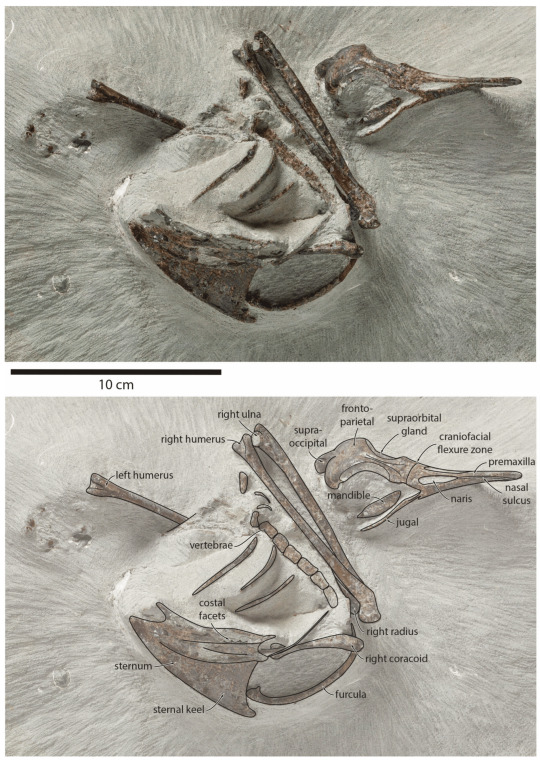
(Type specimen of Ardenna buchananbrowni, from Tennyson et al., 2024)
Meaning of name: buchananbrowni = for John Buchanan-Brown [discoverer of one of the two known specimens]
Age: Pliocene (Piacenzian), 3.06–3.36 million years ago
Where found: Tangahoe Formation, Taranaki, New Zealand
How much is known: Partial skeletons of two individuals, together representing most of the skull, much of the forelimb skeleton, and several vertebrae.
Notes: Ardenna is a genus of extant petrels. These seabirds feed on fishes, crustaceans, and cephalopods using a variety of foraging styles, including grabbing prey while swimming on the water's surface and diving underwater to pursue them. Within the genus Ardenna, the short-tailed (A. tenuirostris) and sooty shearwaters (A. grisea) have particular anatomical specializations for diving, such as flattened humeri (upper arm bones).
A. buchananbrowni also exhibits these adaptations in its skeleton, making it the oldest known diving-specialized member of this genus. It was smaller than most extant Ardenna species, and lived alongside a larger extinct species that lacked diving specializations, A. davealleni.
Reference: Tennyson, A.J.D., R.B. Salvador, B.M. Tomotani, and F.G. Marx. 2024. A new diving Pliocene Ardenna shearwater (Aves: Procellariidae) from New Zealand. Taxonomy 4: 237–249. doi: 10.3390/taxonomy4020012
#Palaeoblr#Birblr#Dinosaurs#Birds#Ardenna buchananbrowni#Pliocene#Oceania#Phaethoquornithes#2024#Extinct
118 notes
·
View notes
Text
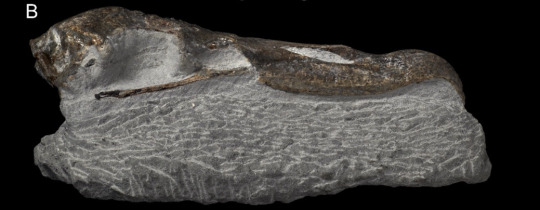
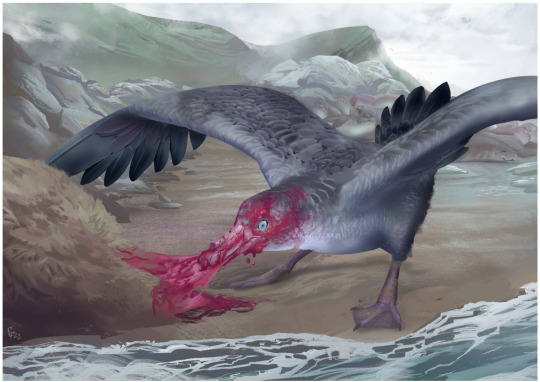
Relatively brief post because I imagine people won't care much about this one (nor is there that much to talk about). But newly described from the Pliocene of New Zealand we have Macronectes tinae, which we might as well call Tina's Giant Petrel. Known from a really well preserved skull and a partial humerus, Tina's Giant Petrel is a species of giant petrel, but notably smaller and less robust than the modern species, like these ones.

There might be two reasons why its smaller. One is simple really. Giant petrels stand out amongst their relatives for being ridiculously big, while all their closest kin are pretty small. So logically, an older, more basal giant petrel is expected to be smaller. The authors also speculate that living in warmer waters is another factor, but modern petrel ranges are huge so that hypothesis is less solid.
Even if it was smaller, Tina's Giant Petrel still lived a life that was likely similar to its modern relatives. Meaning it was an absolute beast of a bird. Modern petrels are well known to scavenge near seal colonies and penguing colonies, mob other birds, steal and eat the chicks of other sea birds and also hunt for fish, squid and crustaceans. Google "giant petrel" and expect to be greeted by birds either absolutely tearing apart carcasses or being covered in blood. Petrels look pretty metal. As it so happens, Tina's Giant Petrel was found in a formation that is in no short supply of potential prey. Eomonachus, a monk seal (illustrated by seal king Jaime Bran), Eudyptes atatu, a penguin (illustrated by Simone Giovanardi), Aldiomedes angustirostris, an albatross, various petrels and an undescribed species of pseudo-tooth bird (skull illustration by Jaime Headden) all would have given the extinct petrel a lot of options.
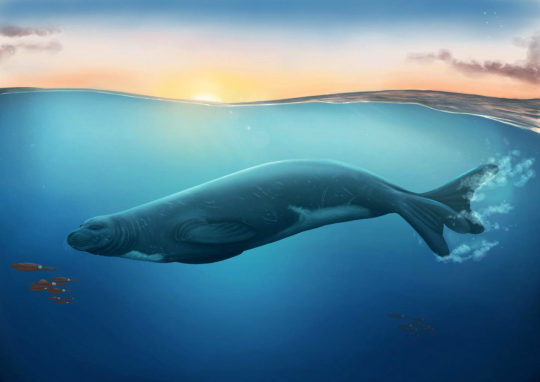

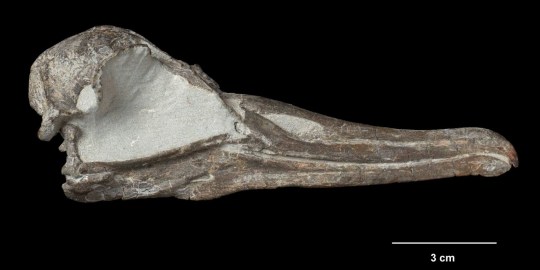
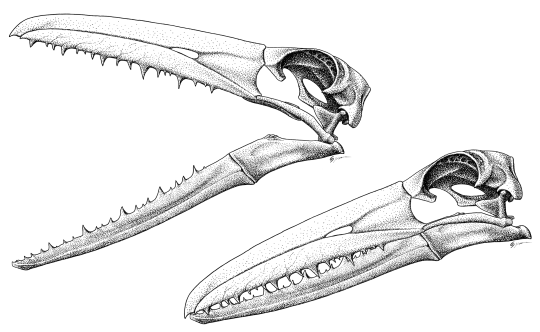
The paper also provides an illustration of the bird itself. Notably the artist, Simone Giovanardi who previously illustrated the penguins up above, decided to give this species darker plumage, reasoning that petrels in warmer waters tend to be darker than their relatives in the colder waters further south. The illustration shows it feeding on the carcass of a seal, probably the local Eomonachus.

Link to the paper: Taxonomy | Free Full-Text | A New Giant Petrel (Macronectes, Aves: Procellariidae) from the Pliocene of Taranaki, New Zealand (mdpi.com) And obligatory link to Wikipedia: Macronectes tinae - Wikipedia
#giant petrel#paleontology#macronectes tinae#seabird#new zealand#palaeblr#technically dinosaur#bird#petrel#extinct bird#pliocene#Tangahoe Formation
55 notes
·
View notes
Text
Eudyptula wilsonae Thomas et al., 2023 (new species)

(Skulls of Eudyptula wilsonae, from Thomas et al., 2023)
Meaning of name: wilsonae = for Kerry-Jayne Wilson [New Zealand ornithologist and conservationist]
Age: Pliocene (Piacenzian), 3.06–3.36 million years ago
Where found: Tangahoe Formation, Taranaki, New Zealand
How much is known: Skulls of two individuals, one belonging to a juvenile nearing adult size.
Notes: Eudyptula is the genus of little penguins, the smallest extant penguins in the world. Found in Australia and New Zealand, two extant species of little penguins are recognized by some taxonomic authorities, whereas others consider them a single species.
E. wilsonae represents the oldest member of this genus known from the fossil record. In terms of its size and anatomy, it was very similar to modern little penguins, but it had a more slender skull overall. The discovery of E. wilsonae supports previous hypotheses that the ancestors of today’s little penguins originated in New Zealand before dispersing to Australia.
Reference: Thomas, D.B., A.J.D. Tennyson, F.G. Marx, and D.T. Ksepka. 2023. Pliocene fossils support a New Zealand origin for the smallest extant penguins. Journal of Paleontology advance online publication. doi: 10.1017/jpa.2023.30
#Palaeoblr#Birblr#Dinosaurs#Birds#Eudyptula wilsonae#Pliocene#Oceania#Phaethoquornithes#2023#Extinct
83 notes
·
View notes
Text
Macronectes tinae Tennyson & Salvador, 2023 (new species)

(Type skull of Macronectes tinae [scale bar = 5 cm], from Tennyson and Salvador, 2023)
Meaning of name: tinae = for Tina King [the late partner of fossil collector Alastair Johnson and whose favorite fossil was the type specimen of this species]
Age: Pliocene (Piacenzian), 3.06–3.36 million years ago
Where found: Tangahoe Formation, Taranaki, New Zealand
How much is known: A nearly complete skull and a fragmentary humerus (upper arm bone), most likely from different individuals.
Notes: The genus Macronectes contains the two extant species of giant petrel, the largest true petrels in the world (with large individuals weighing over 5 kg and having wingspans over 2 m across). They are powerful predators and scavengers that live across much of the southern oceans, preying on crustaceans, cephalopods, fishes, other seabirds, and juvenile fur seals, and have even been observed tearing flesh off the backs of live sperm whales. M. tinae is the first fossil species of giant petrel to be named. It was slightly smaller than modern giant petrels, but appears to have been otherwise similar to them in its overall anatomy.
Reference: Tennyson, A.J.D. and R.B. Salvador. 2023. A new giant petrel (Macronectes, Aves: Procellariidae) from the Pliocene of Taranaki, New Zealand. Taxonomy 3: 57–67. doi: 10.3390/taxonomy3010006
94 notes
·
View notes
Text
Procellaria altirostris Tennyson & Tomotani, 2021 (new species)

(Type specimen of Procellaria altirostris, from Tennyson and Tomotani, 2021)
Meaning of name: altirostris = tall-snouted
Age: Pliocene (Piacenzian), 3–3.4 million years ago
Where found: Tangahoe Formation, Taranaki, New Zealand
How much is known: Partial skeleton of one individual, including the skull and parts of all four limbs.
Notes: Procellaria is a genus of relatively large petrels, including the extant gray petrel (P. cinerea) and white-chinned petrel (P. aequinoctialis). P. altirostris represents the most completely known extinct member of this genus so far. It had a taller beak and shorter wings than other Procellaria species, suggesting that it may have fed in a different manner, possibly being more specialized for diving.
Reference: Tennyson, A.J.D. and B.M. Tomotani. 2021. A new fossil species of Procellaria (Aves: Procellariiformes) from the Pliocene of New Zealand. Papéis Avulsos De Zoologia 61: e20216116. doi: 10.11606/1807-0205/2021.61.16
#Palaeoblr#Birblr#Dinosaurs#Birds#Procellaria altirostris#Pliocene#Oceania#Phaethoquornithes#2021#Extinct
5 notes
·
View notes